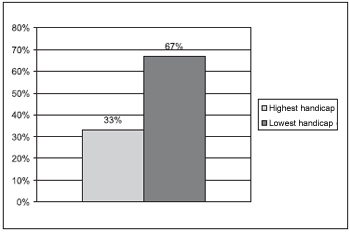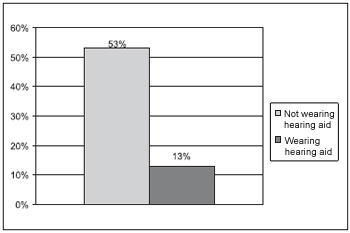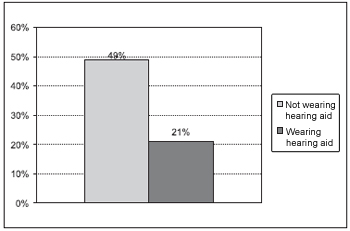INTRODUCTIONAccording to World Heath Organization (1) the third age begins at 65 years in developed countries and at 60 in developing ones. It is understood by a physical, psychic, social and mental decadence of the individual, what leads to a dependence on others and isolation from the world.
Demographic studies show that the maximum period and average expectance of life have been expressively increasing in the last century. On the other hand, aging process effects on sensory abilities still result on lesser functional efficiency, affecting this way the quality of the elderly (2).
One of the worst problems in aging process is hearing deterioration, also know as presbiacusy. Presbiacusy is a factor that establishes aging, causing communication difficulties, though important emotional, social and occupational sequelae (3).
Such hearing loss seems to be a disabling disease and often threatens physical and mental integrity of the individuals leading them to a state of isolation distinguished by depression, stress, frustration and segregation from social life (4).
Presbiacusy is a kind of hearing sensitiveness reduction from aging. It can affect sociopsychological problems arising from the difficulty to communicate to other people (5).
It is common the elderly feel speech understanding difficulty especially in noisy environment (6), considering audiometric configuration of presbiacusy (reduction on high frequencies). Many times, even in quiet environment they complain of such difficulty, considering not only hearing reduction but also the processing of it (7).
A non-proportional implication of speech understanding is often noticed in the elderly, indicating that it can be due to alterations on central nervous system and not only by hearing loss (8). Such issue is explained by the presence of degeneration on central hearing process, due to aging, i.e. innate complementary intrinsic redundancy to central nervous system tend to fall (1).
Besides mentioned difficulties, the elderly also faces social and emotional handicap, resulting from deficiency and hearing inability, which affect family, social and work relations. Handicap is influenced by age, gender and psychosocial, cultural and environmental factors (9).
A good source for patients with presbiacusy is the use of hearing devices known also as hearing aids, which helps speech understanding and process of socialization. Therefore, the use of these devices provides to users normal hearing, or similar hearing to when problem started. Especially in situation of competitive noise, individual with hearing loss do not improve completely (3).
A research, carried in USA in 1982, showed possible reasons for rejecting AASI (Aparelhos de Amplificação Sonora Individual) - Individual Amplification Sound Device by the elderly, such as price, it makes problem evident, worry with excessive noise, handling difficulty, how to purchase it, etc. (10).
Another reason is that hearing aid, by itself, eliminates sound information due to its own limitations, necessary adjustment that might be performed by a speech doctor or even circuit limitations, which can improve speech in some situations, but not in all.
The use of hearing aid is extremely important in order to keep physical and mental health of the elderly, though it enables them a better behavior in community and family relation, improving their quality of life. Nevertheless, due to lack of specific clinical criteria to evaluate the development of the hearing aid on sensorineural hearing loss, it is necessary to analyze its adaptation through a self-assessment questionnaire, with the purpose of verifying level of satisfaction that elderly patients might have wearing hearing aid (11).
The main complaint from users regarding wearing the device was related to noisy environment. The process of adaptation is important in order to assure the effective use in such environment. The success of amplification for the elderly depend on several reasons, such as age, hearing loss grade, tolerance to intense sound, expectations and even motivation. Though, a good follow-up is necessary to guarantee adaptation to hearing aid use (12).
Conventional audiological evaluation provides information related to type and grade of hearing loss. It is essential to evaluate how such loss affects social and emotional quality of life of patient. Self-assessment questions have been used worldwide in order to evaluate and quantify emotional and social consequences of hearing problems in elderly people (4).
Through ABREVIATED PROFILE OF HEARING BENEFIT - APHAB and HEARING HANDICAP INVENTORY FOR THE ELDERLY - HHIE, Almeida (1998) mentioned by (13), researched the benefit of amplification in the elderly and found that the effectiveness of hearing aid adaptation can be attested through objective and subjective measures, including self-perception of handicap and inabilities.
Due to the need of amplification for the elderly hearing handicapped and difficulties on device adaptation, it was established a SOS Hearing Program, with the purpose of verify the level of satisfaction that users of hearing aid achieved before and after it, characterizing handicap and benefit of the hearing aid.
MATERIAL AND METHODSThe current research was approved by the Ethics Committee - Tuiuti University - Paraná, protocol number 91/2004, and by patients signing a Free and Clear Consent Term and answering the questionnaire.
Sample distinguishionPatients included were over 60, who presented, on audiological evaluation, sensorineural, bilateral, descending and moderate hearing loss, and doctor´s report was of presbiacusy.
Sample was composed by 15 individuals, 8 females and 7 males. All of them wore hearing aid in only one ear. Six of them had retroauricular adaptation, three were analogical and three digital. Nine had intra-auricular adaptation, four were analogical and five digital.
Used Material for researchThe 15 individuals (over 60), received their device from SUS. They also submitted to hearing training at UTP and participated on SOS Hearing Aid Program.
In the beginning it was applied HEARING HANDICAP INVENTORY FOR THE ELDERLY - HHIE, adaptation by WIESELBERG, 1997 (13). This questionnaire (Appendix 1) is composed by 25 questions with three possible objective answers, and aims to verify handicap, i.e. difficulties on emotional and social aspects and hearing problem situations.
After one month of hearing aid use (the end of program), it was applied ABREVIATED PROFILE OF HEARING BENEFIT - APHAB, adapted by ALMEIDA, GORGO IORIO and SCHARLACH, 1997 (13). This questionnaire (Appendix 2) is composed by 24 objective questions with the purpose of quantify both difficulty caused by hearing loss and reduction of such difficulty through the use of hearing aid. Although questions were self-assessment-like, they were applied to patients after sections of SOS Hearing Aid Program.
SOS Hearing Aid ProgramThe initiative of helping the elderly hearing handicapped rose due to changes on assistance by SUS in 2005. User patients of hearing aid, in adulthood, had the right of a doctor visiting once a year in order to check their devices. This being the case, patients would remain for a long period with no contact with speech doctors, and probably would have adaptation difficulties.
The Phonoaudiology Clinic at Universidade Tuiuti (UTP) developed the SOS Hearing Aid Program, with the purpose of helping those patients have their possible questions on adaptation period answered, as well as clarify them how to best wear and handle their devices. This group is formed by 10 patients and it is open to interested family members.
This program consists of four meetings at Phonoaudiology Clinic at Universidade Tuiuti. Lectures are given by master students in Communication Disorders.
The content of lectures is:
1 Hearing aid maintenance and cleaning;
2 Hearing process and information on how many types of hearing loss might exist.
3 Hearing aid handling, its components and adjustments;
4 Difficulties on communication process and tips to make it easier.
After a brief presentation, patients can ask their questions, and all of them take part of this procedure. After that, a practical training of how to put the device on, change batteries and to adjust it is performed. On the last day, they are given a manual with lecture summary and practical orientations on the device.
In case of any problems on how to make adjustments, patient is seen individually after this group work.
RESULTOS
Handicap Distinguishion HHIE questionnaire was applied on the first day of SOS Hearing Aid Program. 33% of samples presented greater handicap due to hearing loss, though they answered questions in a positive manner (Chart 1).

Chart 1 - (HHIE) - highest handicap = 33%, lowest = 67%
Through answers from APHAB, which was applied after the last meeting of the SOS Hearing Aid Program, it could be noticed that all individuals refer having been wearing the device from four to six weeks. Regarding daily period, eight patients (53%) wore it for more than 8 hours, six (40%) between 4 and 8 hours, and only one wore it for less than 1 hour a day.
In order to evaluate type of benefit that hearing aid provides, APHAB requires patient to compare their hearing performance with and without it in daily situations.
In order to check benefits from hearing aid, it was considered the answers to questions 01, 04, 05, 06, 07, 10, 12, 14, 15, 18, 23 and 24. They were gathered as it follows:
a) Category 1 - Difficulty in speech understanding in the presence of competitive sounds (questions 01, 06, 07 e 24);
b) Category 2 - Difficulty in speech understanding even in quiet environment (questions 04, 10, 12, 14, 15 e 23);
c) Category 3 - Difficulty in speech understanding in theaters, cinemas or churches (questions 5 and 8)
Answer analysis and their percentage rate were done over average from each category.
Regarding first category, which evaluates the ability of realizing speech in the presence of competitive noise, it was observed that 53% of samples report such difficulty when not wearing hearing aid. This number falls to 13% when wearign it (Chart 2).

Chart 2 - Category 1- Speech understanding difficulty when in the presence of competitive sounds (APHAB) - not wearing hearing aid = 53%; wearing hearing aid 13%
Regarding speech understanding difficulty in quiet environment (second category), it was observed that 49% of samples reports problems in understanding speech when in quiet environment or in optimal situations of hearing when not wearing hearing aid. This number falls to 21% when wearing it (Chart 3).

Chart 3 - Category 2 - Speech understanding difficulty when even in quiet environment (APHAB) - not wearing hearing aid = 49%; wearing hearing aid 21%
Previous results show that 13% of samples reported difficulty in speech understanding in noisy environment when wearing hearing aid, though 21% reported difficulty in speech understanding in quiet environment even wearing it.
The last category refers to hearing quality in ample environment. 66% of samples refers speech understanding difficulty (not wearing hearing aid) when in ample environment such as churches, theaters or cinemas. Only 33% refer such difficulty when wearing hearing aid (Chart 4),

Chart 4 - Category 3 - Speech understanding difficulty when even in theater, cinema or churches not wearing hearing aid = 66%; wearing hearing aid 33%
The qualitative analysis of the results from APHAB, when wearing and not wearing hearing aid shows that there was an improvement on the ability of speech understanding to all users.
DISCUSSIONIn relation to hearing handicap, only 33% of samples reported that patients have difficulties due to hearing loss. Therefore, according to literature (14;2) more individuals presented more complaints, as this study sample is composed by elderly people suffering hearing loss due to age.
53% of population reports understanding difficulty in noisy environment. This information agrees with researched literature (6) when affirming that it is common when an elderly suffers from speech understanding difficulty, due to audiometric configuration of presbiacusy (falling on high frequencies). When those patients wear hearing aid, this percentage falls (13%), what confirms the importance of wearing it, what is encouraged and oriented at the SOS Hearing Aid Program meetings.
Regarding speech understanding difficulty in quiet environment (second category), it was observed that 49% of samples reports problems in understanding speech even in quiet environment or in optimal situations of hearing when not wearing hearing aid. This number falls to 21% when wearing it. Answers not only are due to hearing deterioration, but also to hearing process of elderly population (7; 8; 1). Followed by a follow-up and orientation, patients need a more straight training to this difficulty.
Perception difficulties in ample and noise environment reported by users should be surpassed by effectiveness use of hearing aid and also by adjustments performed during follow-up process.
Adaptation to hearing aid is essential in order to develop good conditions in daily life of an individual.
If devices do not have a proper adaptation, or even do not offer effective profit to socialization for users, they become limited of benefits (14).
Participation of users who submitted to SOS Hearing Aid Program was essential to a good adaptation of hearing aid, according to results from self-assessment evaluation.
The activities developed with that group helped to raise awareness on limitations caused by hearing loss, what produce disposition to wear hearing aid contributing to adaptation of it. Besides, it helps integration and understanding of different environment, providing more self-assurance to patient with hearing loss regarding handling the device.
CONCLUSIONSThis study helped to affirm that follow-up and orientation programs are essential for a proper adaptation of users of hearing aid.
Self-assessment evaluation is important because it helps speech doctors when performing an adaptation follow-up of the devices, as well as it provides to users information on difficulties and easiness towards them.
This study pointed to the fact that handicap caused by hearing loss is important as studied samples showed: hearing difficulty; understanding difficulty; dissatisfaction on relationship; isolation; depression and others.
Regarding questions on device benefits, it was observed that there is an expressive improvement of speech perception and understanding when wearing hearing aid, what provides self-esteem and better integration to social life of users.
Finally, one might conclude that SOS Hearing Aid Program and self-assessment evaluation are essential in order to raise a better adaptation for people with hearing deficit to their devices, besides providing a better understanding to patients and their family on the benefits of wearing them.
REFERENCES1. Russo ICP. Distúrbios da Audição: A presbiacusia. In: Russo ICP. Intervenção Fonoaudiológica na Terceira Idade. Rio de Janeiro: Revinter; 1999, 51-82.
2. Correa G F, Russo ICP. Autopercepção do handicap em deficientes auditivos adultos e idosos. Rev CEFAC, 1999:54-62.
3. Russo ICP. Perfil global do idoso candidato ao uso de prótese auditiva. Rev Pró-Fono, 1999, Set/Dez:426.
4. Silveira KMM, Russo, ICP. A percepção da deficiência auditiva por idosos institucionalizados. Rev Soc Bras Fonoaudiol, 1998:05-11.
5. Tanaka MRT. Déficits de audição em idosos dificultariam a comunicação? Rev CEFAC, 2002:203-205.
6. Pichora-Fuller MK; Souza PE. Effects of againg on auditory processing of speech.International Journal of Audiology., 2003, 42:2, S11-2S16
7. Pichora-Fuller MK Processing speed and timing inaging adults: psychoacoustics, speech perception and comprehension. International Journal of Audiology., 2003, 42:S59-S67.
8. Pedalini MEB, Liberman PHP, Pirana S, Jacob Filho W, Camara J, Miniti A. Análise do Perfil Audiológico de Idosos através de Testes de Função Auditiva Periférica e Central. Rev Bras Otorrinolaringol., 1997, 63:489-496.
9. Dan IB, Iorio MCM. Dificuldade e desvantagem auditivas: estudo em idosos na adaptação de próteses auditivas. Rev Fono Atual, 2004:50-54.
10. Neuber DRD, Blasca WQ, Oliveira JRM. A expectativa do indivíduo idoso com deficiência auditiva quanto ao uso do aparelho de amplificação sonora individual. J Bras Fonoaudiol., 2003, 4(17).
11. Andrade F, Rossino, Motti, F. Adaptação do aparelho de amplificação sonora individual em perda auditiva unilateral: o ponto de vista do usuário. Rev Pró-fono., 1998, 1:46-51.
12. Batista ACM, Sampaio FM. Nível de Satisfação dos Idosos usuários de próteses auditivas doadas pela APAC_NAMI_UNIFOR. Rev Bras em Promoção da Saúde., 2005, 18:7-10.
13. Matas CG; Iorio MCM. Verificação e validação do processo de seleção e adaptação de próteses auditivas. In: Almeida K, Iorio MCM. Próteses auditivas. São Paulo: Lovise; 2003, p. 305-334.
14. Boéchat EM, Russo ICP, Almeida K. Reabilitação do Adulto deficiente auditivo. In: Almeida K, Iorio MCM. Próteses auditivas. São Paulo: Lovise; 2003, p 437-446.
1. Master student (speech doctor)
2. Graduate Speech Doctor by UTP (speech doctor)
3. Master in Communication Disorders (Teacher of
Phonoaudiology Course at UTP)
Universidade Tuiuti do Paraná-UTP
Marine Raquel Diniz da Rosa mrdrosa@yahoo.com.br
Address: Rua Dr. Pedrosa 152 ap 2206 CEP 80420-120 Centro Curitiba-PR (41) 3322-7882
This article was submitted to SGP - Sistema de Gestão de Publicações (Publication Management System) from RAIO on June 23, 2006 and was approved on September 15, 2006 13:30:26.